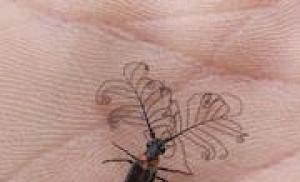How to properly raise sheep at home. Home breeds
Breeding sheep at home for beginners is not as difficult as it might seem. These are very hardy, but most importantly, unpretentious animals, which, with proper care, practically do not get sick, are quite fertile and, in comparison with cattle, require much lower maintenance costs. They don't even need to build capital buildings. In summer, sheep need pens and grazing grounds, and in winter they live in sheepfolds, where it is not necessary to arrange a heating system. Even a rather meager vegetable food is enough for sheep to provide milk and wool. And with balanced feed and good care, high productivity will be ensured.
For information
Keeping rams and sheep at home can be a profitable business. Almost all modern breeds show good performance indicators for milk, meat and wool. As a rule, experienced farmers prefer fertile breeds that are characterized by early maturity, that is, rapid weight gain. There are no clear rules for choosing one or another breed. It all depends on the specific situation. Although, of course, preference is given to animals with good health, unpretentious, well adapted to any conditions.
It is important to take into account the biological characteristics of these animals. Thus, it is worth mentioning that the main psychological characteristics of sheep are their herding and low mental abilities. In particular, a flock on grazing may well forget the way home from the pasture. Therefore, they are usually taken out to the walking area along with more intelligent goats. These animals play the role of leaders - and if at least one sheep follows them, then all the rest will be drawn.

It is important to choose the right breed of sheep to raise, for example for wool, milk or meat. But this is also done taking into account regional climatic conditions. It is best to buy sheep from breeding farms. There are more than 170 of them on the territory of Russia. There is a scientifically based breed selection for each region. Domestic sheep breeding is best developed in the North Caucasus, in the south of the country, in the Volga region. But the sheep do well in the conditions of the Middle Lane. The Romanov, Volgograd, Tsigai breeds are ideal for this. In Siberia and the Southern Urals, it is better to breed sheep of the Edilbaevskaya, northern short-tailed or Gorky breed.
When choosing a variety, its fertility must be assessed. Two factors play an important role here - not only the number of calves per year, but also the number of lambs in this case. However, it is important to pay attention to the survival rate of the young. Most sheep breeds bring offspring once a year - at the very end of winter or early spring. Pregnancy in ewes lasts about five months. In many breeds, the birth of one lamb is considered the norm, but there are exceptions to this rule. For example, the Romanov breed of sheep, the most popular in Russia, is famous for the fact that it has two lambings a year and often several lambs are born at once. Thanks to this, the costs of raising sheep quickly pay off.

During the lambing period, it is important that someone is constantly watching the sheep. An animal's restless behavior is a sign that labor is approaching. About a day before, the udder swells at the uterus. Although everything usually goes smoothly and without human intervention, you still need to control the process.
The average life span of a sheep is about 20 years. But when kept at home, this is, of course, rare. Only pedigree producers and ewes live up to 8 years, since further their productivity is significantly reduced. Slightly fewer animals are kept on farms, bred for the sake of wool. Young animals that are raised for meat are slaughtered until they are one year old.
How to equip a sheepfold
In regions with harsh winters, keeping sheep looks more difficult, in particular, animals need appropriate premises. Sheepfolds do not have to be permanent buildings with a heating system, but they must be warm enough. Wood or brick is used as a material for the construction of such buildings. It is very important to insulate the room and make sure that there are no drafts and excess moisture in it. For this, windows must be provided. which are located at a height of at least 1.5 m from the floor surface so that the sheep do not get to them.

In addition, the sheepfold should be spacious enough. The overcrowding of animals leads to disease. On average, up to 9 m² of area is allotted per individual, but it all depends on the breed. Large animals require more space.
Although the average air temperature in the sheepfold in winter can be only 10 ° C and the animals will feel quite comfortable, it is recommended to warm up the air a little during lambing - at least to 15 ° C. You can transfer an electric heater to the sheepfold, but just make sure that nothing happens to it, since it is still a fire hazardous device.
For young animals, it is advisable to allocate a separate corner. In general, lambs are close to their mother for up to 3-4 months, they cannot be taken earlier.
Animals should be provided with dry and deep enough bedding. For sanitary purposes, it should be changed regularly.
Feeding ewes and young animals
A novice farmer should know how and what to feed sheep at home. Correctly selected feed allows to obtain the highest quality wool and milk. On average, these animals need to be given 3.2-3.5 kg of dry food per 100 g of live weight. There are other rules as well. For example, sheep are more fond of small grass and leguminous hay. It is better to give straw either oat or millet. How to feed the sheep additionally, each farmer decides independently, based on the calculation of the needs for vitamins and microelements. Of the juicy feeds, raw potatoes and fodder beets are recommended (but not ordinary, nothing should be given from your table at all). You can add fodder melons to the diet - watermelons, pumpkin, zucchini. Sheep can be given 2-3 kg of such crops per day.
In addition, animals are offered concentrated cereal feed - corn, barley, oats: this is necessary to balance the diet in terms of feed units.

Breeding rams and ewes has its own characteristics. In particular, the feeding of the sheep in these cases will be significantly different, because they need to take care of the nutrition of the offspring.
The pregnant queens should receive a balanced diet. About 4 weeks before giving birth, the amount of hay in their diet should be reduced and gradually replaced with compound feed. The daily diet of an ewe is 3-3.5 kg of juicy feed or vegetables, which are mixed with cereal and, to a lesser extent, leguminous hay. But after lambing, the amount of hay in the diet can be increased again.
In addition, suckling queens must be given the so-called lick salt, since the body of these animals is already depleted after giving birth. If the lambs do not completely suck the milk, then the ewes need to be milked on their own.
During the first month of life, all nutritional needs of lambs can be met exclusively through breast milk. According to experts, for every kilogram of growth, about 5 kg of sheep's milk is consumed. Therefore, it is very important to ensure milk production at a stable level, especially in winter.

The lambs receive their first milk no later than half an hour from the moment of birth. But it should be remembered that colostrum with its high concentration of substances for the lamb can be harmful, so you need to express the first milk from the sheep, and only after that it is allowed to let the offspring come to it. On the first day after birth, lambs are eaten every 2-3 hours. And within an hour after giving birth, you can give the sheep water.
From 2-3 weeks of age, the lambs are ready to eat hay and succulent feed, although they need to be introduced gradually. From cereals it is better to give oatmeal. You can add finely chopped root vegetables and the best quality hay to it.
Feeding the rams
As already mentioned, sheep breeding has its own characteristics. There are norms that were designed for fertilizers, that is, taking into account their activity. The main food for them is coarse food. In addition, rams need to increase the amount of protein in their food. Sometimes urea is used for these purposes. The daily diet of a ram includes up to 5 kg of forb silage, about 1 kg of fodder beets, 0.5 kg of oat or barley straw (no longer needed, since this negatively affects both the weight gain and the taste characteristics of meat), another 0.2 kg grain feed mixtures. It is recommended to give the animals a vitamin and mineral premix.

Lamb are given legumes, peas, vetch, and in addition - meal and cake: this is necessary to balance the protein diet.
Traditional sheep breeding does not require much effort. Most of the time, animals should spend in natural pastures. Currently, there are few of them, and mainly animals are taken to cultivated pastures. This is especially convenient for a large herd, as it requires minimal attention from the owner of these animals. On the other hand, lambs that live in such conditions show rather low growth rates, so this method of rearing has its drawbacks. They can be smoothed out by improving the quality of the green mass, which is obtained by lambs and sheep at the expense of feed concentrates and vitamins.
Sheep grazing
It is best when the sheep graze in the early morning and evening hours. In this case, it is advisable to alternate grazing with a corral, so that activity is replaced by rest. This is done at least once a week. In the hot months in the southern regions, rams and sheep are driven out to graze at night. It is very important for animals on the pasture to organize a watering hole - at least 2 times a day they need clean water.

In most modern farms, sheep do not use natural pastures, but equipped walking areas. In the summertime, cut grass and concentrated feed are delivered to them. In many regions, the sheep graze on these paddocks during the winter months. Therefore, for convenience, longitudinal feeders are installed there, into which mixtures of concentrates and cut grass are poured. It is best to equip the walking area on a hill and install a canopy in some corner of it so that the sheep can hide there from the rain.
The grazing of artiodactyls has some features that must be taken into account. For example, it is possible to release them to a natural pasture only when the first vegetation has appeared there with a height of at least 8 cm, so that it is convenient for animals to pinch it. If it is cool outside, dew may fall out in the morning. It is necessary to wait out this period, since the wet wool of the sheep does not dry out soon and this can cause various diseases. In general, special care should be taken in the spring and fall to keep the sheep out of the meadow too early. But in the summer, on the contrary, the early appearance of animals on the field will help to find juicy, not yet sun-dried vegetation.
On the walking area, sheep need to organize not only feeders, but also drinkers. They are replenished every day 2 times, in summer in the heat - at least 3 times. In general, the quality of water must be monitored constantly. Poor water can cause dangerous diseases. But dehydration of the body also negatively affects the health of animals.
Excellent meat, rich milk, sheepskin and the warmth of quality wool are the main reasons for breeding them.
The products that are obtained from these animals directly depend on the breed. Let us consider in more detail the maintenance of sheep, their breeding, care and feeding ration.
It is not difficult to keep sheep on your own backyard. These are hardy animals, they are unpretentious and get sick in rare cases, they are quite fertile. If the sheep are compared with the rest of the livestock, then they are distinguished by high early maturity. Sheep are not picky about a capital-built structure:
- On summer days, animals have enough pens and grazing areas.
- On winter days, they are kept in sheepfolds, where the temperature regime is slightly above zero.
Even the smallest vegetation is enough for individuals to grow, build hair and gain weight. They grow excellently on nutrition that will not be enough for other types of animals.
With proper care of animals, breeding them even for inexperienced breeders will not be a difficult and difficult process. Competent care, adherence to the rules of feeding and maintenance is guaranteed even in the initial year, will respond with high rates of meat products, excellent milk and warm wool.
Biological characteristics

Among all the individuals living in the courtyard, they became famous for their herd and sclerosis.
Often, farmers are forced to face a problem, because individuals who have gone to the pasture are unable to find their homes.
Therefore, it is advised to release sheep to pastures, accompanied by clever goats or cows.
In such a company it is only necessary for one sheep to go after the "leader", so all the others will follow it.
The life span of sheep reaches twenty years. But, being kept in a personal backyard, only producers and thoroughbred females are able to live up to eight years. Young animals that are raised for meat are slaughtered for up to a year, and representatives of the wool line are kept a little longer.
The main indicator of the superiority of a breed or an individual animal is the number of lambs per year and the number of calves brought. Often, sheep bring a brood once a year by the end of winter or early spring days. The gestation period lasts about five months, as usual, in most breeds, the birth of one calf is the norm. But there are also special cases.
For example, the Romanov species is very relevant among Russian breeders due to the frequent birth of several cubs at once and the possibility of lambing twice a year. Such a pedigree feature and early maturity of individuals in general makes it possible to draw up a successful, actively profitable business plan for breeding livestock.
Keeping sheep in the summer season
Sheep belong to the pasture type of animals, in spring and summer days they should be grazed on pastures. In particular, greens in the pasture form the basis of their diet during these periods. Pastures are distinguished by the following options:
- artificial appearance when the soil is sown with herbs
- natural natural appearance
- with the presence of perennial plants
- with the presence of annual plants
Not all cattle breeds are actively switching from the winter feeding season to the summer season. This means that animals need to be gradually switched to green fodder. And not all grazing grasses are suitable for. Damp and wetlands are not suitable for grazing, because unbalanced feeding provokes the appearance of various ailments in animals.

Due to the fact that sheep are not particularly agile, and they have a particularly developed herd instinct, it is not easy to graze them.
Their slowness and disorientation in space are associated with low vision, so the sheep try to stay close to each other.
It happens that after grazing, the cattle still find their way home, in the event that they are fed there.
On summer days, sheep consume up to ten liters of water, therefore, it is necessary that a drinker or a reservoir is located near each pasture. The system of keeping animals implies a clear grazing schedule. Namely: from 5-6 in the morning to 8-9 in the evening. In the event that we grow them for fattening, then both in summer and winter days they are kept in stalls.
Keeping sheep in the winter season
On winter days, the animals are kept in stalls. They perfectly tolerate the cold, which means they are not demanding on the special conditions of detention. Feeding sheep in the winter at home is practiced on the basis of feeding hay, harvested from the summer, and also by adding a variety of purchased feed. During the winter, an adult animal consumes at least five hundred kilograms of hay, at least five hundred kilograms of silage and other juicy food, and fifty kilograms of concentrates.
When there is a shortage of hay, thirty percent of it is replaced with straw of oat and spring wheat, as well as straw of legumes. Animals also eat well branch fodder, which is harvested on summer days from young shoots of trees with foliage.

Almost everyone feels much more favorable if they stay in dry climatic territories.
They should walk constantly throughout the year.
This is impossible to achieve only in our latitudes.
Although these animals tolerate confined spaces worse than others, you need to build a kennel or sheepfold for them.
This is exactly the place where the cattle will come from grazing, where they will spend the winter, and also lamb.
Sheep housing is required to be as close as possible to their natural environment. Wooden walls, clay floors, there should be good ventilation, but no through winds.
The room must be dry, equipped with lighting, which implies the presence of windows and an additional light source. The interior of the barn assumes the presence of a nursery, feeders, partitions. The total area will be determined based on the calculation: four hundred square meters for two hundred head of livestock. An adult needs two square meters of free space, a lamb needs one square meter. As usual, the layout of the building is angular with windows for a normal amount of light.
We will divide the room into two parts (for the lamb and for the non-lamb). In the middle of the building we will set aside a room for the staff. It is more successful to build an additional annex, it will separately provide the opportunity to place rams so that they do not attack females during the period of decline in sexual activity.
The warmth inside the building on cold days is maintained by the animals themselves. In winter, depending on the temperature regime, the stall must be sheathed with insulation if the temperature is below -10. It happens that a stove is installed so that the lambs do not freeze, because their wool cover is still not enough to heat themselves.
In the event that walking the animals is not possible due to the lack of pasture, we will acquire an aviary. We fence off the open air area, which will adjoin the sheepfold. Sheep do not tolerate moisture well. In order for them to have a shelter from the rain, an additional covered building is needed, in which a watering place can also be organized.
For lambing sheep, a specially equipped separate room is required, where the female will not be disturbed. The temperature regime of the air in this room should not be less than ten degrees. The usual temperature range is from 10 to 18C. Therefore, when lambing on winter days, this compartment is additionally heated. It is better to take into account all these parameters even in the planning of the construction of a sheepfold.
We save food for animals. The diet
Adequate nutrition takes into account the daily intake of two kilograms of hay, about three hundred grams of concentrates, about ten grams of table salt, as well as feed chalk and a mixture of vitamin supplements. The menu should be based on hay. Its volumes in the Russian Federation are stored once a year for the entire period, such is our specificity of animal husbandry. In other words, hay will need to be purchased during the summer.
The duration of grazing in greenery varies depending on the regions of Russia. In one area, animals are recommended to graze for six months, in another - only three months. Based on this, the required volume of hay is calculated. It is sold in the form of rolls from two hundred and fifty kilograms or in bales. The average weight of a bale with hay is fifteen kilograms, but much depends on the strength of the hay press by the machine. The dimensions of a normal bale, as usual, are 1.2 by 0.6 by 0.4 m. Taking into account the dimensions of the bale and our own possibilities of stacking them in a pyramid, we can calculate the place needed to save hay.
It is especially important to remember that it cannot be laid out directly on the ground, you need to put food for your pets on cargo pallets and cover it with banners on top, providing protection from precipitation. The more compacted the hay, the less moisture it will absorb.
If the farmer pursues the idea of improving the quality characteristics of meat, then the work of caring for the lamb should be taken into his own hands and he will have to be taken away from the female on the third day after birth. These should be fed artificially.
Such a variation is beneficial for a small subsidiary farm and provides an opportunity after a short time to wait for new offspring. To increase the number of individuals, both artificial insemination and natural fertilization are practiced.
Caring for sheep is not particularly difficult. It only takes a few months to grow them for meat. From the age of three months, young lambs can be slaughtered. It is better to carry out this event before reaching the age of nine months.

The coat is trimmed twice a year.
In spring, most often, it is produced from rams with a uniform coat.
In the event that they have a mixed coat, then it is better to transfer the haircut to the autumn period.
Breeding animals in the northern regions, while keeping individuals of the coarse-haired type, they are sheared three times a year.
If this favorable period for shearing is skipped, then there is a risk of losing half of the wool as a result of the molt that has begun in the lamb.
Sheep breeds
A novice breeder should decide on the purpose of breeding sheep and, based on this, make a choice in favor of a certain breed: meat, meat-wool, fat-tailed, etc. Caucasian view, Altai view.
The wool-meat type of sheep gives out moderately thin wool and is subdivided into representatives with a long coat and a short coat.
Long-haired representatives include varieties:
- Kuibyshev type
- Tien Shan type
- North Caucasian species
- Romney March view
- Russian long-haired species
The short-haired subspecies are represented by Lithuanian, Latvian and Estonian sheep. They grow actively, and their meat is of high quality. To create carpets, cloth and furs of excellent quality, it is advised to look at the Tsigay and Georgian sheep representatives. And also the Karakul and Romanov species belong to the fur coat subspecies.
It is noted that the Romanov sheep are universal: they have excellent meat and dairy products, high offspring. The animals are actively growing, they hardly get sick and can be considered one of the best variations for inexperienced breeders.
Balabas, Tushinskaya and Karachai varieties give excellent marks for meat, wool and milk. For breeding fat-tailed individuals in order to obtain meat, lard and wool products from them to create felt, it is worth turning your interest to Edilbaev or Gissar species. Such individuals are the largest among their counterparts, their mass sometimes reaches two hundred kilograms.
The profitability of sheep breeding
An inexperienced breeder who decides to start raising sheep is initially interested in whether he will benefit or not. To do this, we will calculate the planned financial costs.
Sheep breeding, as a traditional type of farming activity, allows owners to receive significant profits and natural products for marketing. To increase the efficiency of production, the farmer must know where to start work, how to properly organize the premises for keeping animals, and most importantly - what should be the diet of the sheep for their active growth.
Sheep breeding is undoubtedly one of the traditional farming activities around the world. Sheep have been raised as a pet for a long time. Sheep raising involves raising sheep on a commercial basis, for the purpose of making a profit, from the sale of meat, milk and wool, as well as for personal use. Sheep breeding can be called a fairly profitable farm, sheep are fertile and unpretentious in care. Most of the time they feed on pasture food. Although sheep farming is not the best solution for milk production, however, it justifies itself in meat and wool production in full. If you have your own funds and want to start a farming business with the aim of obtaining profit, then sheep breeding is for you in the best way.
In a short time, sheep breeding may well justify itself, you will get back the money you spent and make a profit from the sale of sheep products. In order to start your business based on sheep breeding, you need to correctly formulate your goals and develop a competent business plan. Consider all costs, major and indirect, in terms of costs. This article will describe the advantages and disadvantages of a sheep-based business and the first steps in starting a business.
Why sheep breeding
Sheep are raised for meat, wool and leather. Sheep meat is nutritious and tasty. It is popular with different segments of the population around the world. Sheep breeding is undoubtedly an excellent source of income, if the process of breeding animals is properly organized. Sheep thrive on any pasture and are suitable for breeding in almost any climatic zone. The benefits of running a sheep business include the following:
- Sheep breeding does not require huge investments.
- Due to their unpretentious care, sheep can live in any area and in any home that meets the needs of animals.
- Labor costs for running a sheep-breeding business will be minimal.
- Sheep are distinguished by high rates of reproduction and growth. You can easily double the number of animals in a relatively short period of time.
- Sheep are unpretentious in food, they eat any pasture plants, easily endure long distances in search of food on the walk, eat weeds. Most of the time the sheep graze in the pasture, which will undoubtedly reduce feed costs.
- Sheep, unlike goats, do not feast on tree bark and do not harm garden vegetation.
- Sheep can easily tolerate the consumption of low-grade feed - and this is a savings, as opposed to an expensive diet.
- Sheep products are very popular and occupy almost a leading position in the fields of livestock farming.
- Sheep are hardy and unpretentious, they easily tolerate temperature extremes due to their wool, which creates a kind of microclimatic shell around the animal.
- Sheep have a calm disposition and are suitable for joint breeding with other types of animals on a farm or private household.
If you follow the rules of caring for animals and proper organization of sheep breeding, this business can become stable for you and bring good earnings. You will be able to give additional jobs, thereby helping the population in the fight against unemployment.
Sheep farming as a commercial activity plays an important role in the national income of a country. Sheep can become the basis of a profitable business in animal husbandry, as part of the economic growth of the state. With the right approach and competent organization of the sheep breeding process, there is an opportunity to enter international markets, to sell their products, as well as the opportunity to contribute to an increase in national income.
Where to start sheep breeding
Sheep are small in size, unpretentious and calm in nature, therefore keeping sheep will not bring you much trouble. But, as with starting any other farming business, you need to draw up a business plan as well as an expense plan. Determine the payback period for your sheep breeding business. Next, you need to choose the right place for your future farm. The land plot should be located away from major roads, it should have a clean and fresh source of water (if there is no communication), enough greenery for sheep grazing, the area should be protected from predatory animals. Try to take into account the rather simple requirements for the future site, so that later you will not have problems when building a farm, and even more so when grazing animals.
Choosing a breed of sheep
Try to select sheep of proven breeds, from experienced breeders and well-known farms and breeders. Today you can count a huge number of breeds. But each breed has its own area of destination. There are breeds suitable for wool production, there are specially bred for the meat industry.
One way or another, you need to have clearly set goals for the production purpose of animals before choosing a breed. Some of the common woolen breeds are such as: merino, Stavropol, Caucasian, Altai, Tsigay, Romanov and others. The meat direction includes the following breeds: Edilbaevskaya, Gissar, Texel, Kuibyshev, Dorper, Vendée and others.
Sheep do not require much maintenance and expensive housing. They will be grateful to you for meeting their basic content needs. Sheep can be kept together with other farm animals. However, in order to breed sheep commercially, it is necessary to build a separate dwelling suitable for keeping the animals.
The house for keeping sheep should be warm, environmentally friendly, suitable for safety criteria in adverse conditions. It must protect the livestock from predators and bad weather. Sheep are not so demanding on the availability of space, so animals can be kept more densely than, for example, cattle. The main thing is to provide a room for keeping animals with good ventilation, sufficient light and heat. Keep the sheepfold dry and clean by building a good drainage system inside the house and running a drain pipe. Change the bedding of the animals. Do not make the sheepfold too tall, it will heat up worse. To make the pasture safe, many farmers have built a fence around the site to graze their sheep.
The fence should be strong enough so that sheep cannot go outside and predators cannot enter the pasture area. The invention of the "electronic shepherd" will serve as a good alternative to the fence; this equipment will help keep the herd safe and sound. It can be easily assembled and carried, if necessary, from place to place.
Sheep diet
Good feeding is essential for proper growth and maximum production. High quality food helps keep your pet healthy, productive and immune to disease. Sheep eat any plant food in the warm season, and eat hay well in the cold season. Sheep spend most of their time on pasture eating grasses and plants, young shoots of shrubs. Vegetables and fruits, as well as cereals, can and should be introduced into the diet of sheep to increase the nutritional value of plant foods. Sheep should have clean and fresh water at all times. Diversify the diet of sheep and mineral stones, to replenish the lack of animal minerals in the body.
In order to establish the correct process of raising sheep and, accordingly, in the future receive a stable income from your sheep breeding business, you need to follow some rules of the sheep breeder. Try to study the literature on sheep breeding, talk to experienced sheep farmers.
Breed selection and acquisition of sheep, mating and selection of rams, pregnancy of sheep and lamb, culling of young stock, caring for livestock, keeping all types of records, vaccination and diseases of sheep, as well as methods of combating them - all this is a very important component of the commercial activity of sheep breeding.
When buying sheep, pay attention to the behavior, an active animal with a good appetite should attract your attention when choosing. Pay attention to your farm, provide a varied diet, vaccinate your livestock on time. To keep your production process from idle and your sheep breeding to flourish, consider all of the above tips when laying the foundation for your future sheep farming business.
Sheep problems
Any business, be it a farm or any other enterprise, carries some risks and problems, respectively. And sheep breeding is no exception in this situation. When starting your sheep breeding business, you may encounter some of the common problems, such as protecting your animals from predators and diseases, when building houses and shelters for them, and others.
Of all the problems, protection from predators is probably the most pressing problem. Therefore, to eliminate it, get yourself a large shepherd dog, and install protective structures around the perimeter of your site. The second major problem is disease, and there is a solution to this. Sanitize the sheepfold on time, do not feed the animals with low-quality or stale feed, timely prevent diseases and vaccinate against various diseases, using the services of veterinarians.
So, in the end, I would like to point out that sheep are a traditional livestock business. Before starting to create a sheep farm, you must choose the right breed. Since the maximum profit is largely dependent on the selection of high production qualities of the animal and a healthy livestock, start reading articles and books about sheep breeding before deciding to build a farm.
Visit long-established farms and learn more about caring for and keeping sheep. Good care and management will surely ensure the maximum profit from your farming business. Try to take care of your animals. Purchase highly productive, proven sheep breeds, feed the animals with highly nutritious fresh feed, and vaccinate livestock in a timely manner. Decide on marketing strategies for the sale of products derived from sheep breeding. Study the sales market and its demand for agricultural products of sheep breeding. And you will undoubtedly become a successful sheep business businessman.
Business relevance
Livestock farming is not in great demand today among start-up entrepreneurs. But market analysis shows that it is profitable to work in this area, and the threshold for entering the business is low.
Sheep breeding is a traditional branch of animal husbandry, which is a promising area of activity in the field of agriculture.
Advantages:
- The sheep breeding process cannot be called laborious - animals are unpretentious to food and housing conditions.
- The presence of constant demand, the absence of a seasonality indicator.
- Low feed costs as sheep are grazing animals.
- Small start-up investment (you can start doing this business at home).
- Increased demand for mutton, lamb, and young sheep.
- Low level of competition.
- Availability of profitable credit programs for the development of agriculture.
Sheep breeding as a business for a novice farmer is characterized by great development prospects. Among the disadvantages can be called a relatively low profitability, although much depends on the characteristics of the organization. Substantial experience and effort can bring the farmer to the break-even point after 3-4 years. The lowest rate of profitability is 10-15%, but even in this case, if you invest the proceeds in the development process, you can build a solid and reliable business.
Related videos:
Business plan composition
A sheep breeding business plan is as follows:
- planning of the main activity - raising young sheep for resale, dairy, meat sheep breeding, etc.;
- purchase or lease of a land plot;
- registration of permits;
- purchase of animals, inventory, feed;
- search for personnel (shepherd, veterinarian, workers);
- search for sales channels for products;
- control over farm activities.
Related videos:
Financial plan
The amount of initial investment and the level of return depends on the selected region, direction, breed and characteristics of the organization. An approximate financial business plan for sheep breeding (for 300 head of cattle) consists of the following sections:
- Basic costs
- purchase of sheep - 750 thousand rubles;
- lease of a land plot - 120-150 thousand rubles;
- preparation of premises for keeping sheep - 75 thousand rubles;
- remuneration of personnel - 250 thousand rubles;
- purchase of feed - 50 thousand rubles;
- unforeseen expenses - 75 thousand rubles.
- Profit
- from the sale of meat - 400 thousand rubles. (200 rubles / kg.);
- from the sale of young sheep - 300 thousand rubles. (5 thousand rubles per head);
- from the sale of wool - 75 thousand rubles.
With proper housekeeping and favorable conditions, the payback period will be 2-3 years. Calculations are based on sheep breeding.
Related videos:
Features of keeping sheep

Where to start breeding livestock?
A suitable pasture is required to raise sheep. When calculating its size, proceed from the fact that 1 hectare of land is needed to keep one sheep with offspring per year. In other words, to raise 200 head of cattle, you need a 200 hectare pasture.
The room for their keeping does not have special requirements, for example, a wooden cattle corral. Animals tolerate cold well, so keeping sheep in winter is possible without special heating. In severe frosts, you can install a potbelly stove.
The most optimal regions for sheep breeding are the Caucasus, the Republic of Kalmykia, the Astrakhan region, the Krasnodar and Stavropol Territories. These areas are favorable for sheep breeding. But in these places, finding a suitable pasture is not easy. It is easier to achieve this goal in Central Russia, but the feed will be of a different quality.
It will not be possible to feed the sheep on grass alone; it is necessary to constantly buy grain, which increases the cost of keeping. In the northern regions, livestock grazing is possible from May to October, so additional spending on special feed and animal maintenance is required.
Related videos:
Choosing a breed of sheep
The productivity and payback of a business depends on the breed of sheep, of which there are enough today. When choosing which sheep to breed, start from the goals and directions of the business. Sheep, depending on the purpose, are divided into three types of breeds - meat, wool and dairy.
- Edilbaevskaya breed;
- Gorkovskaya;
- Romney March;
- North Caucasian and Tien Shan;
- Romanovskaya;
- Fat tail;
- Hissar;
- Vendée and others.
Sheep of the Romanov breed are the most widespread in Russia. Already in 4 months, the lamb gains 50% of the weight of an adult ram, and at the age of a year - 85-90%. Moreover, they are unpretentious in feeding and care.
Fat-tailed sheep are the most adaptable and survivable in the world among other breeds. They are bred to obtain lamb fat.
For dairy sheep breeding, it is better to choose a breed:
- Tsigai;
- East Frisian;
- Awassi;
- Asaath.
Wool breeds:
- Mikhnovskaya;
- Merino South Kazakh;
- Kuchugurovskaya.
Experts recommend starting sheep breeding for meat, since the cost of wool has decreased in the last decade, and sheep milk is practically not in demand. Meat breeds are hardy, disease resistant, and gain weight quickly. The first purchase should be made with experienced breeders.













